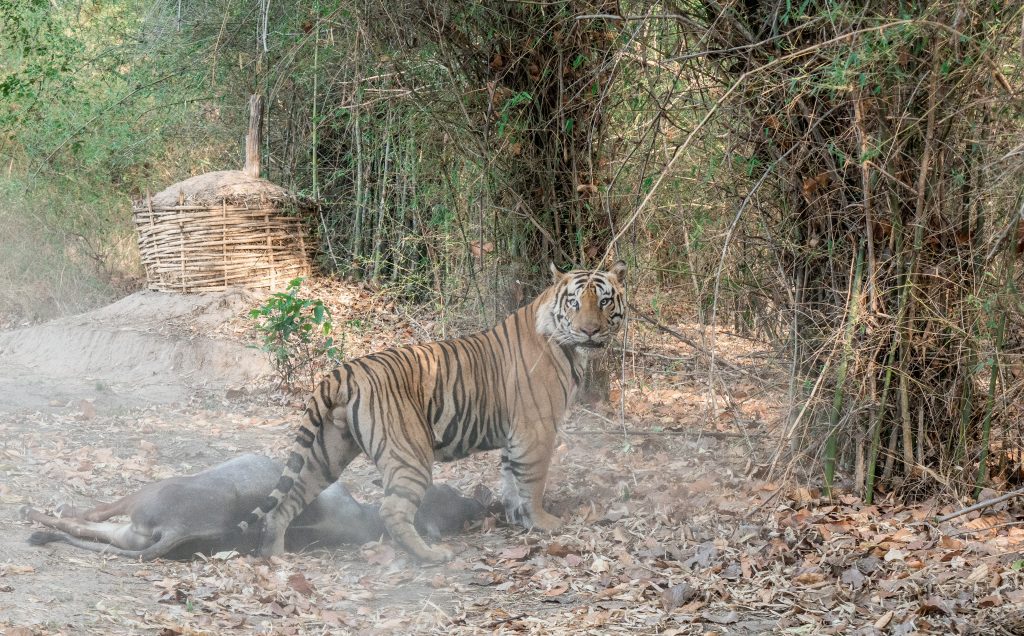Tigers are the keystone species that play an integral part in conserving our pristine eco-system. They inadvertently safeguard our rivers, forests, and a variety of wildlife that co-exist on their estate, including human species. They are admired for their strength, valiance, agility, and beauty, which are inimitable in God’s other creations. Yet, despite so many studies and research on these majestic felines, we continue to discover new things about their elusive lives and uncover more interesting facts about tigers.
In Indian culture, tigers play a significant role. It has long represented majesty, strength, beauty, and fierceness, which has been linked to courage and gallantry. In Hindu mythology, the tiger plays a vital role in Goddess Durga’s conveyance.
Tiger hunting was formerly regarded by monarchs and noblemen as one of the finest forms of courage.
The tiger is a rare animal that is essential to the variety and health of an ecosystem. At the top of the food chain, it is a top predator. As a result, the existence of tigers in the forest is a sign that the ecology is healthy. Tiger conservation in forests safeguards a variety of other species habitats.
Numerous ecosystem services, such as the preservation of rivers and other water sources, the reduction of soil erosion, and the enhancement of ecological services like pollination and water table retention, are among the indirect advantages.
There are in Total 9 subspecies of tigers in the world.
Out of 9 species of 3 species of tigers are extinct as mentioned below.
- Bali tiger (Panthera tigris balica): Found on Bali Island and went extinct in 1940.
- Javan tiger (Panthera tigris sondaica): Found on the Indonesian Island of Java and went extinct in 1980.
- Caspian tiger (Panthera tigris virgata): In the 1970s, the Caspian tiger—also known as the Hyrcanian tiger or Turan tiger—went extinct.
- The Sumatran tiger (Panthera tigris sumatrae): lives on the Indonesian island of Sumatra and is the smallest member of the tiger family.
- Siberian tiger (Panthera tigris altaica): Often referred to as the Manchurian tiger, Korean tiger, Amur tiger, or Ussurian tiger, is a threatened species that reside in Northern Asia (China, Russia, and Korea)
- The Indochina tiger (Panthera tigris corbetti): Is named after the well-known British hunter Jim Corbett and is also referred to as Corbett’s tiger. Native to Southeast Asia (China, Thailand, Laos, Burma, and Vietnam), the Indochina tiger is nearly critically endangered.
- The Malayan tiger (Panthera tigris jacksoni) : Is sometimes referred to as the Southern Indochinese tiger. Southeast Asia, specifically Burma, Thailand, and Malaysia, is where it originally came from.
- The South China tiger (Panthera tigris amoyensis): Is also referred to as the Chinese, Xiamen, and Amoy tigers. It is indigenous to Jiangxi, Guangdong, Fukien, and Hunan provinces in eastern and central China.
- Bengal tiger (Panthera tigris tigris): The Bengal tiger, also known as the Indian or Royal Bengal tiger, is a native of the Indian subcontinent. The Bengal tiger is now found in India, Bangladesh, Nepal, and Bhutan.
So in India, we have one species of tiger called the Bengal tiger.
We share with you some interesting facts about tigers:
1. Tigers are the Largest of all big Cats

Of all the big cat species in the wild, tigers are the largest and the heaviest. An adult Siberian tiger can weigh up to 320 kg and measure 11 feet in length (head to tail), while the male Bengal tiger from India can measure up to 10 feet in length and weigh 250 kg.
In fact the second largest cat in the wild, the African lion measures 8 to 9.5 feet in length and weighs up to 190 kg is a bit smaller.
2. Tigers can make different sounds

Tigers are blessed with the ability to communicate in several distinctive sounds with each other. They use it to display their mood, affection, distress, and dominance to others. They can hear ultrasonic and low-frequency sounds. They rotate their ears to catch any source of sound.
Some of the sounds which we may hear on tiger safari are territorial roars, distress calls by cubs, affectionate chuffing, wrestling sounds, mating roars, moaning, grunting, and whining.
3. Tigers can Climb on Trees

Yes, you heard right. Tigers can easily climb trees but they seldom do so, except when the cubs are young. Their sharp and retractable claws provide a powerful grip to hold the tree trunk and climb up comfortably. And as they grow old their body weight hinders them to do so.
Despite this, there are records of adult tigers climbing trees to catch leopards and monkeys.
4. Tigers Love Water

Tigers are fond of water and spend many hours dousing at the edge of lakes, ponds, rivers, and waterholes. They submerge themselves, soaking up to the neck during the hottest time of the day.
They can drink up to 15-20 gallons of water and are excellent swimmers.
5. A Tiger’s Night Vision is 5-6 times better than humans

Humans have a layer of dark pigment cells behind the retina which absorbs extra light, whereas tigers and other nocturnal animals have a layer of reflective tissue behind the retina called tapetum lucidum, which provides a second opportunity for the eye to catch the light, thus improving their night vision manifolds.
Also know about the: Tiger Sleeping Habits
6. Tigers Locate each other with their Sense of smell

Tigers can interpret and gather information from the air, or the scent left on the trees, scratch marks, droppings, etc. by other cats.
They inhale the scent by raising their lips, exposing their fangs, and a hanging tongue and wrinkled nose to draw the scent to the rooftop of their mouth to their Jacobson organ. This works as a chemical transmitter to tell the tiger about the presence of its sibling, a female, or an intruder.
7. Tiger’s Saliva has Antiseptic properties

Unlike humans, tiger saliva contains lysozyme enzymes, which attack the cell walls of wounds providing defense against infection. They also lick themselves now and then to clean their coat.
Their tongue is sharp and rough, covered with papillae that help remove the fur and feathers from their prey while feeding.
8. Tigers like to avoid humans

Tigers lead a secretive life and are shy by nature. They normally avoid humans and skip the area when intervened, unless they are injured, with cubs, or on a kill.
Even in the park they avoid the patrolling guards and move into the bushes. They do become man-eaters due to prolonged hunger, injury, habitat loss, or when old. Some pick this habit from their mothers and incidences in Sunderban hold true to this example.
9. Tigers are ambush hunters
Tigers prefer to conceal themselves in their environment and use the wind direction to their benefit before making a kill.
Their stripes camouflage well in the bush, tall grass, and bamboo thickets letting them move in closer to their prey. They stalk them and slowly reach a striking distance – freezing completely, before sprinting for the final step. That’s why they are called ambush hunters.

Tigers toil very hard to achieve success and to avoid detection. Every watchful eye in the wild screams their lungs out to announce that the big cat is on the move. They alert other denizens with alarm calls. Thus, it takes 10-12 attempts for tigers to seize their prey finally.
10. Tigers are solitary mammals

Tigers lead a lonesome life in the wild and only spend a brief amount of time while mating, raising cubs, and growing up.
Tiger cubs develop this innate behavior in the early stages of their life, as this becomes quite prominent after 8 to 10 months amongst the siblings. And as they grow old, they start avoiding each other and explore the realms of their mother’s territory, till they part ways to find their niche.
Male tigers protect the females from trespassers, thus helping her to raise the cubs with him.
Also know about the: Evolution of Tigers
11. Tigers create virtual boundaries invisible to the human eye

Tigers frequently mark their territories and create virtual boundaries for other felines as an entry barrier, in their treasured estates. They do this by spray marking and scratch marking on the trees, scat dropping on the safari track, near waterholes, and trails. And roaring while patrolling their territory as a sign of dominance in their area.
12. A tiger usually eats only once in a week and can eat up to 18-20 kgs in one go.

A tiger on an average needs 50 to 60 spotted deer size deer in a year. So in a year there are 52 weeks so it means the tiger eats once in a week. But this ratio might change if the tigress is with cubs who have started feeding on the meat. A tigress raring her cubs might have to hunt 2 times in 10 days.
Once it has killed a full size deer like sambar which might weigh 300kgs, the tiger will feed for around 4 days. There are records of tigers eating around 18 to 20kgs of meat in one sitting.
13. Tigers will mate around 50 times a day and copulation might last less than 15 seconds.
Tigers don’t have a particular breeding season, they mate when the tigress is in estrous and ready to mate. The tigress will spray mark the trees with her urine and the territorial male coming across will get the smell and by doing flehmen the male tiger will come to know that the tigress is on heat and ready to mate.
They will communicate with each other by roaring and finding each other’s location. During mating time the male and female tigers have been seen together for 4 to 5 days.
14. It’s only 1 in 10 hunting attempts that a tiger is successful.
Tigers hunt in different situations. If they come upon their prey and have not eaten, they can hunt it down instantly. However, because tigers see at night six times better than humans do, they have an edge over their preys.

Tigers pursue their prey by hiding in plain sight and ambushing it. When the prey is within 50 yards of the tiger, it will suddenly accelerate to a top speed of 45 km/h, crushing its prey with a bite that has a 1000 pound force and shattering its spinal cord.
15. Tigers can snooze for up to 18 to 20 hours each day.

They enjoy taking their naps in cooler environments. These can include regions with shaded vegetation such as thickets, cliffs, caverns, tall grasses, dense trees, shallow water bodies, and occasionally even comfy game trails that are muddy or sandy.
In spite of disruptions, they can pretty much sleep anywhere in their region. If you’re interested in learning more about the tiger’s sleeping patterns, visit our separate blog on tiger sleeping habits.

Exploring the interesting facts about tigers is like taking the first step on an exciting adventure to get to know these awesome creatures better! If you’re super excited about seeing how amazing they are in real life, check out our guide to the top places to see Tigers in India. And don’t forget to read up on where they live, how they act, and what we can do to help protect them.
Edited By: Natasha Sinha, Content Curator, Pugdundee Safaris
Visit our the Luxurious Lodges in Different location:
The Best Resort in Kanha National Park, Luxury Resort in Tadoba, Resort in Bandhavgarh National Park, Resort in Pench, Resorts in Satpura, and Panna to watch various fascinating species of the forests frolic in the untamed wild.
Get in touch with our trip curators at Pugdundee Safaris to book your next wildlife holiday.
Our trip curators at Pugdundee Safaris are more than happy to assist you. Phone: +91-011-40132680 Email: [email protected]



